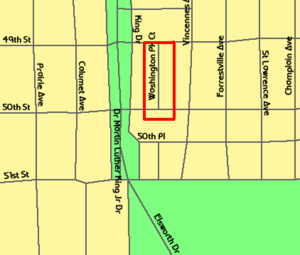Washington Park Court District facts for kids
 |
|
| Maintained by | Department of Streets & Sanitation |
| Location | Chicago |
| North end | East 49th Street (one-way east) |
| Major junctions |
East 50th Street (hosts additional contributing properties.) |
| South end | East 50th Street (one-way west) |
The Washington Park Court District is a special neighborhood in Chicago, Illinois. It's located on the city's South Side. This area was officially named a Chicago Landmark on October 2, 1991.
Even though it's called "Washington Park," this district is not actually inside the Washington Park neighborhood or the Washington Park park. It's just one block north of them. The district got its name because it's close to the famous park.
The district is known for its row houses. These houses were built between 1895 and 1905. You can find them at 4900–4959 South Washington Park Court and 417–439 East 50th Street. Many of these homes share similar looks and designs.
Contents
Exploring Washington Park Court
Washington Park Court is a unique street in Chicago. It's only one city block long. Traffic on the street goes one-way northbound. This means cars can only drive from East 50th Street to East 49th Street.
The City of Chicago recognized this street and some nearby homes as a special district. This happened because of their unique history and architecture. In May 1990, the district was considered for landmark status. It officially became a Chicago Landmark on October 2, 1991.
How the District Got Its Name
The district was named after the nearby Washington Park. This famous park was designed by a very well-known landscape architect named Frederick Law Olmsted. He designed many beautiful parks across the United States.
The Homes and Their Style
The T. G. Dickinson Real Estate Company started developing this area in 1892. They made a rule that all properties had to have a 10-foot (3.0 m) setback. This means the houses had to be built a certain distance back from the street.
Most of the row houses in the district were built between 1895 and 1905. By 1990, there were forty-nine row houses. They showed off many different building styles. These included Classical Revival and Romanesque designs. As of 2004, the district had fifty-one properties.
Architects like Henry Newhouse and developers Andrew and John Dubach helped shape the look of the block. They designed many of the homes. Most houses are made of brick and limestone. They often share similar porch and cornice lines. Many also have mansards or recessed roofs with bay fronts.
A Look at the Neighborhood's History
The Washington Park Court District has an important history related to how Chicago neighborhoods changed over time.
Changes in Population
Between 1900 and 1934, the number of African Americans living in Chicago grew a lot. It went from 30,000 to 236,000 people. At first, these new residents lived in many different parts of the city. But over time, they became more concentrated in certain areas.
During this period, some property owners used special agreements called restrictive covenants. These agreements were used to prevent African Americans from buying, renting, or living in certain properties. This was a way to enforce segregation, which meant keeping different racial groups separate.
Community Efforts and Challenges
In the first half of the 20th century, a part of Chicago's South Side was sometimes called "The Black Belt." This area was home to many African Americans. Some local business people and the University of Chicago worried about changes in these neighborhoods.
The Washington Park Court Improvement Association was a group in the area. At first, they worked on making the neighborhood better, like planting trees. But later, they focused on keeping segregation policies in place.
Since the 1930 United States Census, the Grand Boulevard area, where Washington Park Court is located, has been home to mostly African American residents. In both the 1960 and 1990 Census, over 99% of the people in this community area were African American. By the 2000 Census, this was still true, with 98.2% of residents being African American.


